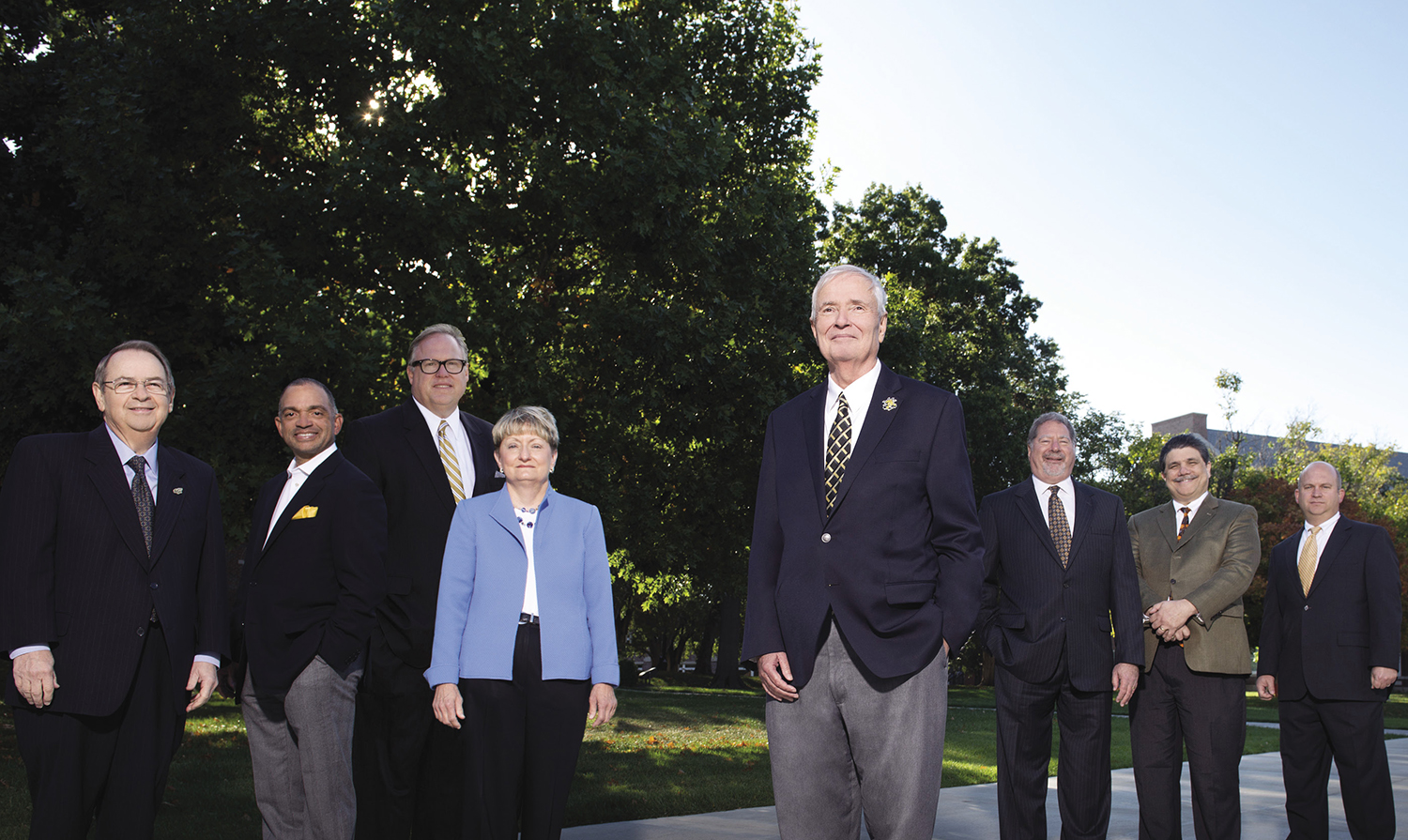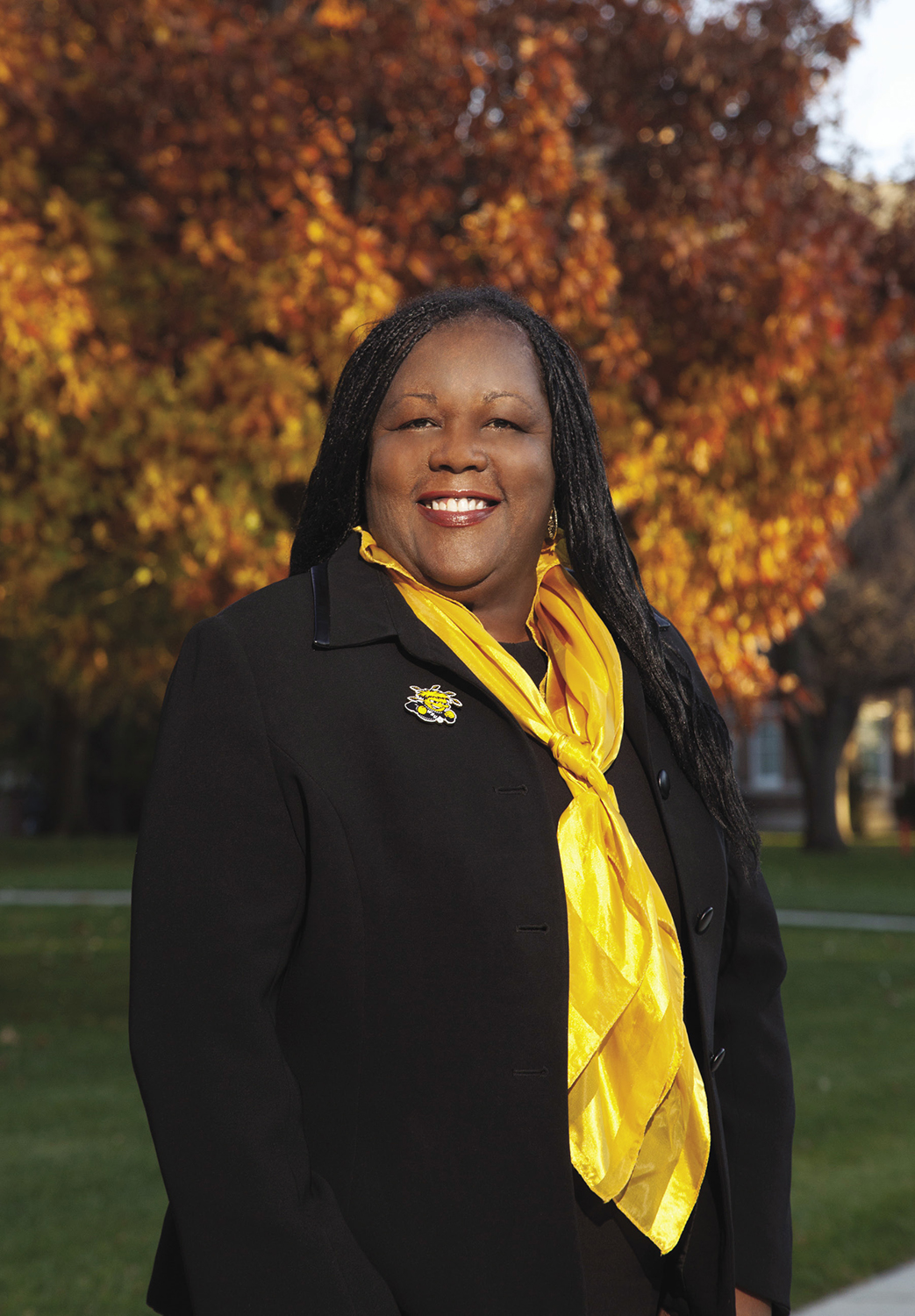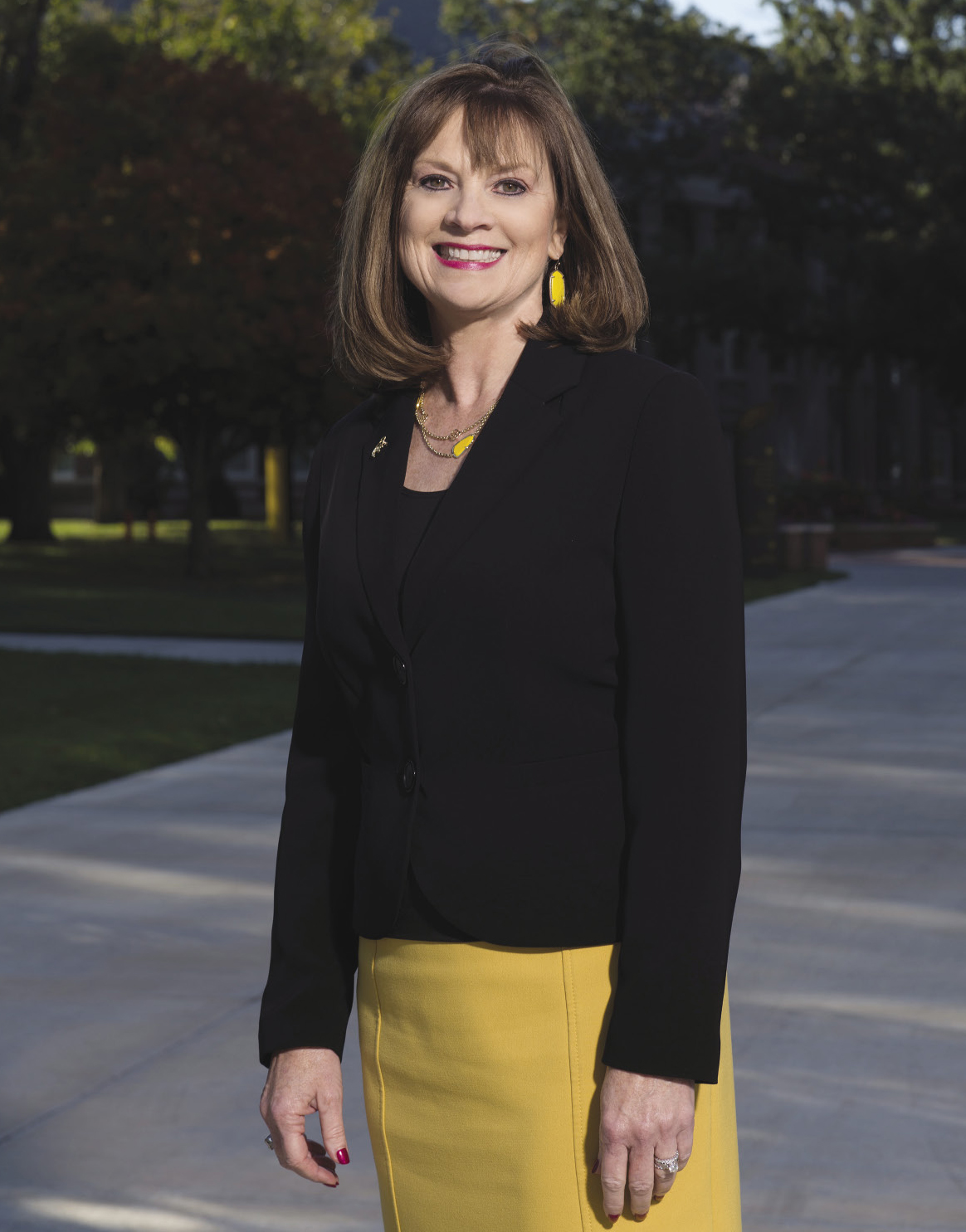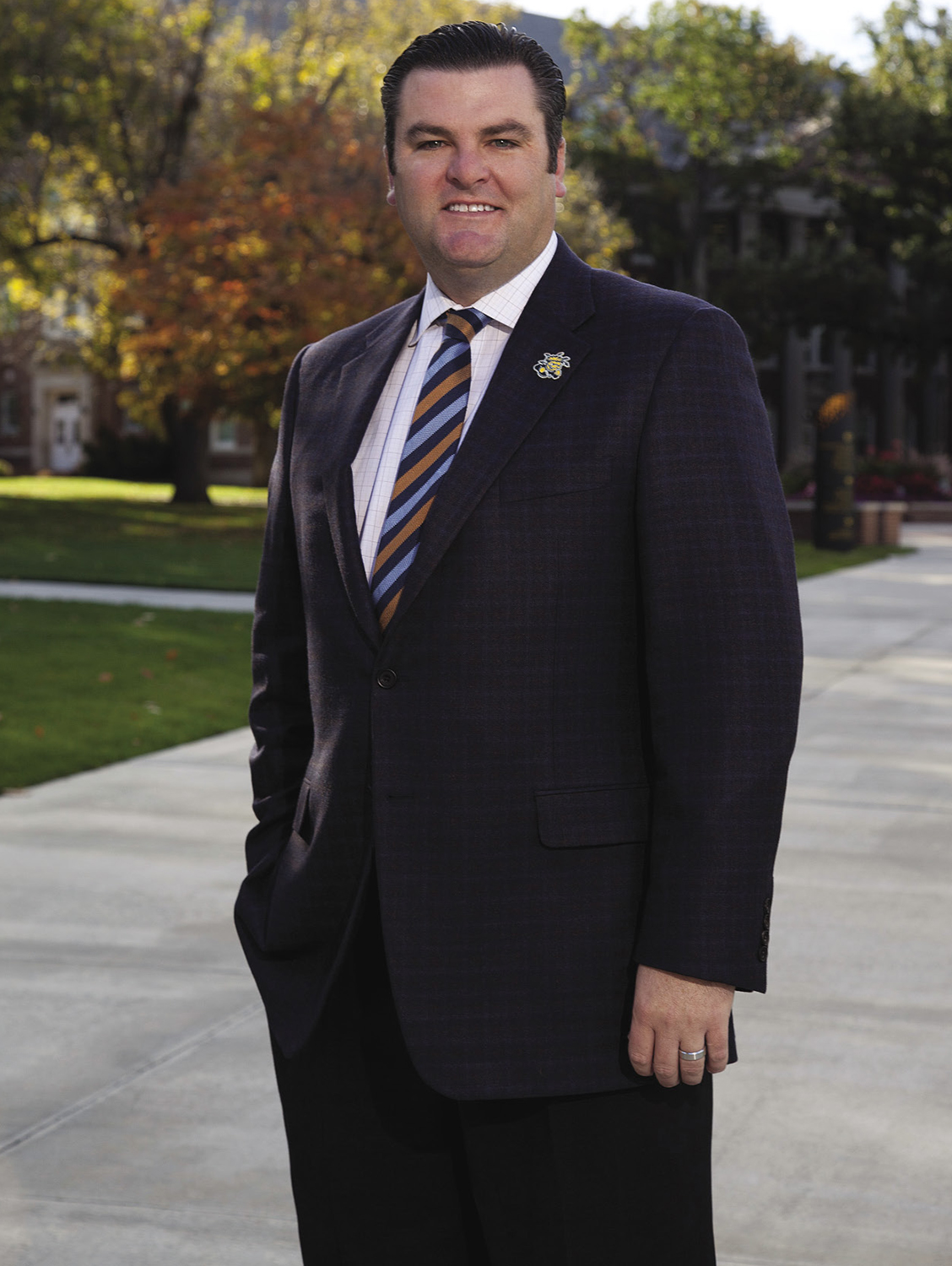
Eric Sexton, Andrew Schlapp, Mary Herrin, WSU President John Bardo, David Moses, Tony Vizzini, and John Tomblin.
The year 1926, like all years, has its own unique list of goals met and milestones passed.
It has its own look and feel. Its own high marks of technology: Television is first publicly demonstrated on Jan. 27 in London; the first transatlantic telephone call is made from London to New York on March 7; nine days later, American engineer, professor, physicist and inventor Robert Goddard launches the world’s first liquid fuel rocket — which may have traveled only 184 feet before crashing to the ground, but helped usher in the Space Age.
Atop Fairmount Hill, just north of Wichita’s downtown, the institution of higher education that had been set up in 1895 as Fairmount College was, in 1926, undergoing a transformation. Faced with new fiscal realities, Fairmount was carving out a new identity — led by President John Finlayson, who had arrived on campus in 1922. He learned during the early days of his presidency that Fairmount was not on solid financial ground. Instead of continuing to focus on finding a private school solution, he championed the municipal university idea that was succeeding in larger cities across the country. He decided the best way to save Fairmount was to gift it to the city.
But the transition from college to city university was not without its difficulties, and it took the efforts of administrators, faculty, students and alumni to persuade the citizens of Wichita to accept Fairmount as its university. Alumni, according to a 1924 article in the Sunflower, “heartily endorsed the Municipal University plans sponsored by Dr. Finlayson at the Alumni-Faculty entertainment held in the Morrison Library.” The report continues, “The purpose of converting Fairmount College into a University is to provide a superior institution.”
Kathleen Walsh ’28/39, one of Fairmount’s 460 students in 1924, worked to support the proposition for a city university. “We students rolled up our sleeves, spent time at City Hall going over registration lists and went door to door urging people to vote ‘yes,’” she said. But put to a vote in 1925, the proposition failed. “So we just did it all over again the next year. It passed, and in 1928 I proudly graduated from the University of Wichita.”
From concept to reality: a big dream, hard work, fresh ways of doing things and a culture of change at the college level resulted in the hard-won establishment of the ninth municipal university in the nation and the first west of the Mississippi River. The first WU commencement took place on June 7, 1927, when Finlayson conferred degrees upon 52 graduates.
In time, though, it became evident that to fulfill its aspirations WU needed a broader base of financial grounding than the city could provide. After another hard-fought political battle, WU was admitted into the state system of higher education. In November 1963, before WU became Wichita State University on July 1, 1964, President Emory Lindquist presented his thoughts on The Idea of a University, saying in part: “This is our university, and what it will become depends upon the joint dedication, vision and concern of many people.”
THESE DAYS, Wichita State is undergoing another transformation, another change of identity in response to the changing ground of higher education. This transformation is being guided by the university’s 13th president, John Bardo, who was formally inaugurated on Oct. 12, 2012, with the inaugural maxim Ad Astra, “to the stars.”
In his inaugural address, he said, “Wichita State is not just a university in the city, it is a university of the city. Being of the city has always made a huge difference, and all indications are that in the globalized world, it will be of even greater importance.”
Months earlier, as a finalist for the position of WSU president, he remarked, “This university is extremely well positioned for the future. The rocket is on the launch pad, and it’s ready to go.” After taking office on July 1, he outlined a number of priorities; among them: improving the quality of campus life, increasing enrollment, enhancing research efforts and technology transfer. (For more on Bardo, read “Blueprint for Change.")
Now three years into his tenure, Bardo has put up a student residence facility; Shocker Hall, with its 784 beds, opened on Aug. 14, 2014. He has pulled together, with input from campus constituencies and the wider community, a longterm strategic plan that features a university-wide emphasis on innovation and becoming an internationally recognized model for applied learning and research. And he has put together a uniquely qualified executive team to assist him in leading the way from concept to reality.
THE TEAM, comprised of nine members, including Bardo and its newest member Marché Fleming-Randle, meets weekly on Mondays in venerable Morrison Hall. “One of the things you’ll see about the whole executive team,” says Bardo, who’s comfortably seated in his Morrison Hall office one October morning, “is that I have a tendency to believe people who can laugh together tend to do better together because you can break the tension and get down to real solutions.”

member, appointed assistant to the president
for diversity just this November.
Of all the team members, Bardo says, Anthony “Tony” Vizzini is “probably the person with the quickest wit.” An engineer, educator and administrator, Vizzini holds a PhD in aeronautics and astronautics from MIT, and worked and led research at Maryland, Mississippi State and Western Michigan before coming to WSU as vice president for academic affairs in 2013. Now provost and senior VP, Vizzini says that one of the proudest times for him comes “at Commencement when our students achieve the desired goal of an academic credential from WSU. It’s a celebration.”
John Tomblin, a Bloomfield Distinguished Professor of Aerospace Engineering who has been at WSU since 1994, serves as VP for research and technology transfer and as executive director of the National Institute for Aviation Research. “He’s kind of the energizer bunny of the group,” Bardo says with a laugh. “I’m not really sure that he sleeps.” Tomblin, with a decidedly entrepreneurial mindset, oversees 15 labs in four locations and 350 employees.
“In 2003, NIAR had an operating budget of $18 million and only 11 percent was industry-funded,” Tomblin reports. “Today, thanks to a highly capable team of researchers and students, we’ve increased to a $45 million budget that is 57 percent industry-funded, and we rank first among all U.S. universities in industry-funded aerospace R&D.” Bardo credits Tomblin with having “huge credibility off-campus. He understands where universities are having to go.”
Mary Herrin ’72/76, VP for administration and finance, has been with WSU since 1973. “Mary brings the combination of a love of the university and clear professional competence,” Bardo says. “Plus she’s a consummately kind person.” A past president of the board of the Central Association of College and University Business Officers (CACUBO), Herrin has also served in leadership roles for the national organization NACUBO.
Herrin notes that she and her staff have a ground-level commitment to and pride in “maintaining a fiscally responsible campus.” Excited about “the expansion of our building inventory,” Herrin names the completion of Shocker Hall and the renovation of the Rhatigan Student Center as two examples.

of individuals united in helping him fulfill his
vision," says Elizabeth King, president and
CEO of the WSU Foundation. "We're focused
on creating a learning environment where
innovation, creativity and entrepreneurship
come together."
Eric Sexton ’87/92 was named to the positions of VP of student affairs and executive director of athletics in April 2015, but he has worked at WSU for two decades. “Having been on this campus for 25 years, I think I’m most proud of working every day side by side with individuals and students in the spirit of my mentor Fred Sudermann — doing a good job at the job that needs to be done.” Bardo notes that “Eric cares about students. That affection for individual students as human beings really plays out with him. That sense of the individual student — that he lived himself as a student-athlete here — he brings that to the table.”
Lou Heldman, former Wichita Eagle president and publisher, joined WSU’s faculty in 2007 as Distinguished Senior Fellow in Media Management and Journalism. His roles at WSU include serving as interim director of the Elliott School of Communication and then the Center for Entrepreneurship. “In summer 2014,” Heldman says, “President Bardo asked me to take on a new role, vice president for strategic communications. The best parts of my job are working with leaders and communicators across the university on strategic issues, such as shaping our messages about becoming an Innovation University.” Bardo reports, “Lou has a level of professionalism around communication that is hard to find. He is someone who can lighten the load and get work done.”
Andrew “Andy” Schlapp ’92 came to WSU in 2008 as executive director of government relations and board of trustees. Today, he is also executive director of Wichita State Innovation Alliance and Operations. “Andy,” Bardo says, “has a political sense that you rarely find on a university campus. His sense goes all the way from ‘How do you pass bond issues?’ to ‘How do you work with the legislature and the governor?’ — and everything in between. He’s as good as I’ve seen.”
For Schlapp, job satisfaction comes from, he says, “getting to meet WSU employees, hear about the work they’re doing to change the world, and share that information with community, also our state and national leaders. To see the excitement on the faces of these leaders about the great work happening makes me proud to work at this university.”

and chief operating officer.
David Moses, named WSU general counsel this past summer, has practiced law for 36 years, most recently as managing member of the Wichita firm Moses & Pate LLC. No stranger to campus, he has taught the course Legal Issues in Sports Administration for the past 10 years. “David is a fun addition,” Bardo says. “He has a great sense of humor. He also brings litigation experience to the table — so he brings a different view with him.”
What impresses Moses most about WSU, he says, is “its people. The commitment of students, staff, faculty and administrators to make WSU the best higher education option is unbelievable. Building a strong partnership with neighbors, the city, county and private business is exciting and will help achieve the mission of everyone on campus.”
Marché Randle-Fleming is the newest team member, appointed assistant to the president for diversity just this November. Taking on her role with gusto, Randle-Fleming says she is looking forward to “moving WSU forward in diversity and working with President Bardo on diversity issues.” She adds there are a number of plans in the works, including implementing the President’s Diversity Council.
In addition to Bardo’s executive team members, Elizabeth King, president and CEO of the WSU Foundation, and Darron Boatright, deputy athletics director and COO of the athletics department, are key go-to administrators. “One of the things about these jobs,” Bardo says about top administrative positions in general and his role as WSU president in particular, “they kind of become all-consuming. There are four issues I spend a lot of time on.”
THE ISSUES that stand as top priorities for Bardo and his team are enrollment, technology transfer, research, and the quality of student life.
“Enrollment is our number one focus this year,” Vizzini says. “Enrollment includes recruitment and retention. We’re exploring different strategies to provide a variety of curricula to our traditional and nontraditional students and looking for ways of serving the wider community through our educational products.” Bardo adds, “The market changed under Wichita State. If you look, our enrollment went from about 17,400 at its height to now in the 14,500 to 15,000 range. That’s not a good trend. How do we best reclaim and reposition ourselves in a market that now has a very different set of competitors?”
In response to the changed market, WSU is coming up with a complex of enrollment-services strategies and degree offerings that, over time, could result in far more than rising enrollment. To mention only one of the initiatives: students coming to WSU from the Tulsa, Okla., and OKC metro areas can now pay the same tuition as in-state students – opening up a market of some 2 million potential students at in-state rates. And that’s just the start of things. Statistically, it can be expected that of those who come to WSU from 10 to 30 percent would remain in Kansas, thus helping grow the state’s workforce. “There’s a lot of valuable stuff that adds up right there,” Bardo notes.
The goal, Tomblin adds, is to “provide a new type of graduate. One who is fully prepared to enter the workforce before even crossing the stage to accept a diploma. In order to do that, we have to maintain close relationships with a wide range of industries and constantly reevaluate programs based on the knowledge needed to thrive in the workplace.”
Technology transfer — the movement of innovations, knowledge and techniques from originators to others — is a crucial conduit in the healthy functioning of any economy, from the global to the regional and local. “Entrepreneurship and innovation are two drivers of the future,” Bardo says. “Wichita prides itself on being the cradle of entrepreneurs, and yet if you look at the current data, it’s not true.” In a recent study of entrepreneurial activity, Wichita was ranked 277th out of the top 300 Metropolitan Statistical Areas, while in the top 100 in population. “We’ve got to help figure that out,” he says. “It’s a huge issue, and we have minimal infrastructure to help with that any more.”
In basic research, Wichita State has several areas of strength, Bardo says. “We need to find ways to broaden those strengths across the university.”
The quality of student life is absolutely key, says Bardo. “Your education improves a lot the more time you spend engaged,” the president says. But the bottom-line challenge is that quality costs money. “Balancing the absolute need for a quality education with the costs of providing it — we talk about that nearly every day,” Bardo says.
“We have to find ways to remain fresh in our ideas, thinking every day as to how we can continue to push and grow,” Boatright says. “I’m in my 25th year here at Wichita State,” King says. “I have seen significant changes, but never at the pace that is currently occurring.” Bardo adds, “We’re making progress on a lot of fronts. I’m looking forward to the fundraising for our new Ideas Lab, for instance, and settling up on a couple more contracts related to the Innovation Campus. I really do feel like we have the capacity to do what we need to do.”
Bardo pauses for just a moment and says, “I want us all to be going northwest. I don’t care how we go. You might be in a canoe. I might be in a buggy. But we’re all going northwest. I do feel like the institution is more and more moving in one direction.”
Toward a one and only Shocker of an Innovation University.





